Electrochemical Gradients (BMS1 ppt 3)
1/95
There's no tags or description
Looks like no tags are added yet.
Name | Mastery | Learn | Test | Matching | Spaced |
|---|
No study sessions yet.
96 Terms
The electrochemical gradient is an electrical and chemical difference btwn the INTRACELLULAR and EXTRACELLULAR environment maintained by the cell membrane and its permeability properties
Define electrochemical gradient
Resting Membrane Potential (RMP)
What is this membrane potential called in excitable cells?
Potassium (K+)
What is the main cation in the intracellular space?
Phosphate (PO4) and proteins (aa's)
What are the main anions in the intracellular space?
Sodium (Na+)
What is the main cation in the extracellular space?
Chloride (Cl-)
What is the main anion in the extracellular space?
+66 mV
What is the equilibrium potential for Na+?
In most of the extracellular fluid, there are equal numbers of + and - charges
There is an equal number of + and - charges near the plasma membrane
There is an equal number of + and - charges in most of the cytosol
Explain the distribution of charges of the intracellular/extracellular space
Chloride ion
Sodium ion
Phosphate ion
Potassium ion
(Proteins*)
Distribution of ions is unequal across the membrane
Which ions are in the intra/extracellular space? How are they distributed?
1) Unequal distribution of ions across the membrane
2) Relative membrane permeability for Na+, K+, and Cl-
3) Permeability is 50-100x greater for K+ than for Na+
What factors contribute in the production of a resting membrane potential?
50-100x greater for K+ than for Na+
So is permeability greater for K+ or Na+ ? By how much?
1) Graded potentials (small stimuli)
2) Action potentials (greater stimuli)
So which two types of electrical signals do excitable cells (muscles and neurons) use?
Graded potentials (small stimuli) are used only for short distance communication, while
Action potentials (greater stimuli) are used in large distance communication
Differentiate when graded potentials vs action potentials are used
Voltage-gated channels
Open in response to direct change in membrane potential. Gives neurons and muscle fibers the property of excitability (ability to respond to certain stimuli producing impulses)
The voltage-gated channels open due to a change in membrane potential.
The membrane potential of the closed K+ channel is -70 mV while the membrane potential of the open gate is -50 mV.
Again, why do the voltage-gated channels open? What is the membrane potential when the voltage gated K+ channel is closed vs. when it opens?
Ligand-gated channels
Works in response to specific chemical stimuli and have specific binding sites for ligands (eg. neurotransmitters or hormones)
Chemical stimulus opens the channel
Again, what opens the ligand-gated (cation) channel?
Chemically-gated ion channel
Works in response to specific chemical stimulus changing membrane permeability. There are 2 types.
They open channels for Na+, K+, and Ca 2+
How do direct chemically gated channels work?
They work via membrane protein (protein G) as a second messenger system (activates an intracellular cascade)
How do indirect chemically gated channels work?
Mechanically-gated ion channels
Works in response to vibration (eg. pressure- sound ear waves, or stretching- Pacinian corpuscle)
Depolarizing or hyperpolarizing
At short distances, graded potentials can be
An action potential is an electrical signal (change the resting membrane potential in >10-15 mV) produced in excitable cells under proper stimulation leading to a sequence of rapidly occurring events that result in:
1) Depolarization
2) Repolarization
What is an action potential? What does it result in?
Depolarization is the increase and eventual reversal of membrane potential. It requires a stimuli to depolarize the resting potential to a critical value (threshold; >10-15 mV)
What happens in depolarization? (try to visualize the graph to help you)
Na+ channels
Depolarization depends on:
K+ channels
Repolarization depends on:
Plotting voltage across the cell membrane (mV) against time, the action potential begins with depolarization, followed by repolarization, which goes past the resting potential into hyperpolarization, and finally the membrane returns to rest
Visualize the graph of an action potential and try to explain it.
When the excitable cell goes under the resting potential
-the cell moves under -70mV and its close to -90mV (equilibrium potential of potassium).
-the V-gated channels still open
What is hyperpolarization?
absolute vs relative refractory period
What are the two different refractory periods?
Time in which a second action potential can be initiated by a supra threshold stimulus. Coincides with period when voltage gated K+ channel open after inactivated Na+ channels have returned to resting state
What is the relative refractory period?
The resting membrane potential is similar to the equilibrium potential of potassium. For this reason, the excitable cell is more permeable to potassium than sodium.
Tell me about the conductance of sodium and potassium. Which is the excitable cell more permeable to? (note- for the test, pls study the graph of conductance)
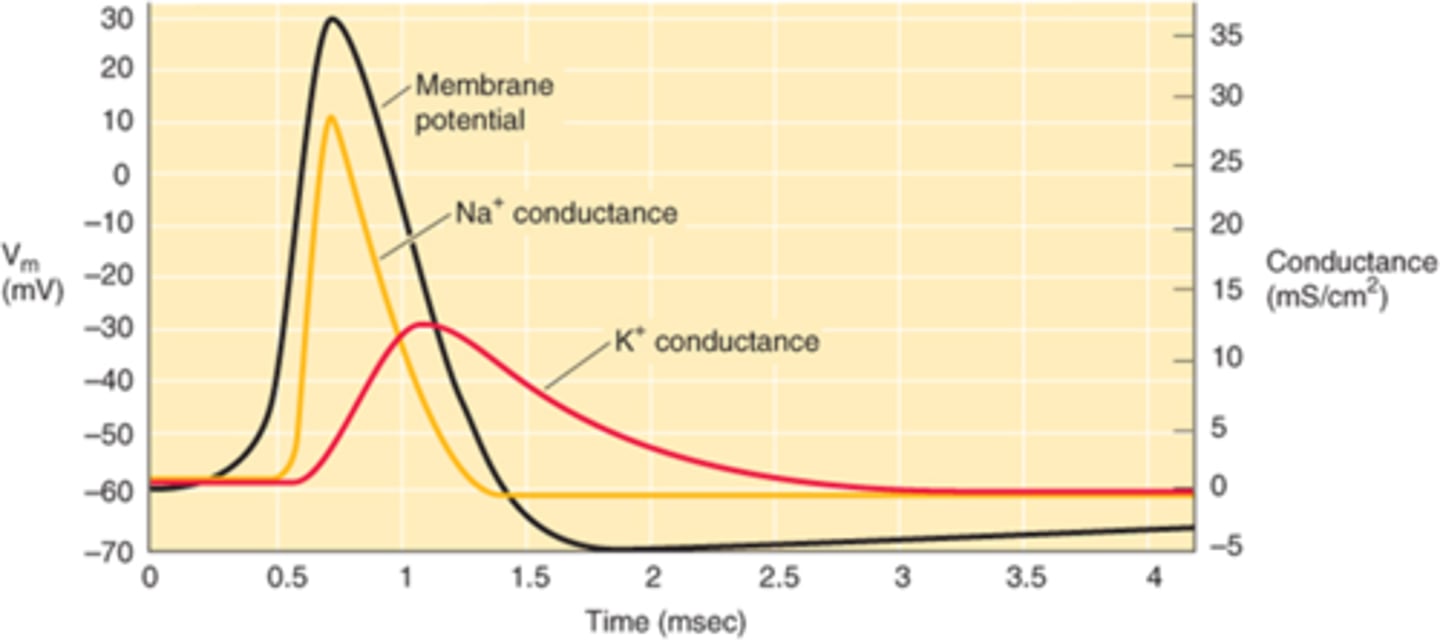
Phase 0 (Depolarization) - a lot of Na+ goes in
Phase 1 (start of repolarization) - K+ leaves
Phase 2 - Ca2+ goes in
Phase 3 (repolarization continues; membrane potential decreases) - K+ leaves
Phase 4 - Na+ and Ca2+ channels are closed but the K+ channel opens
During the cardiac muscle action potential, explain what goes in and out of the cell during each phase.
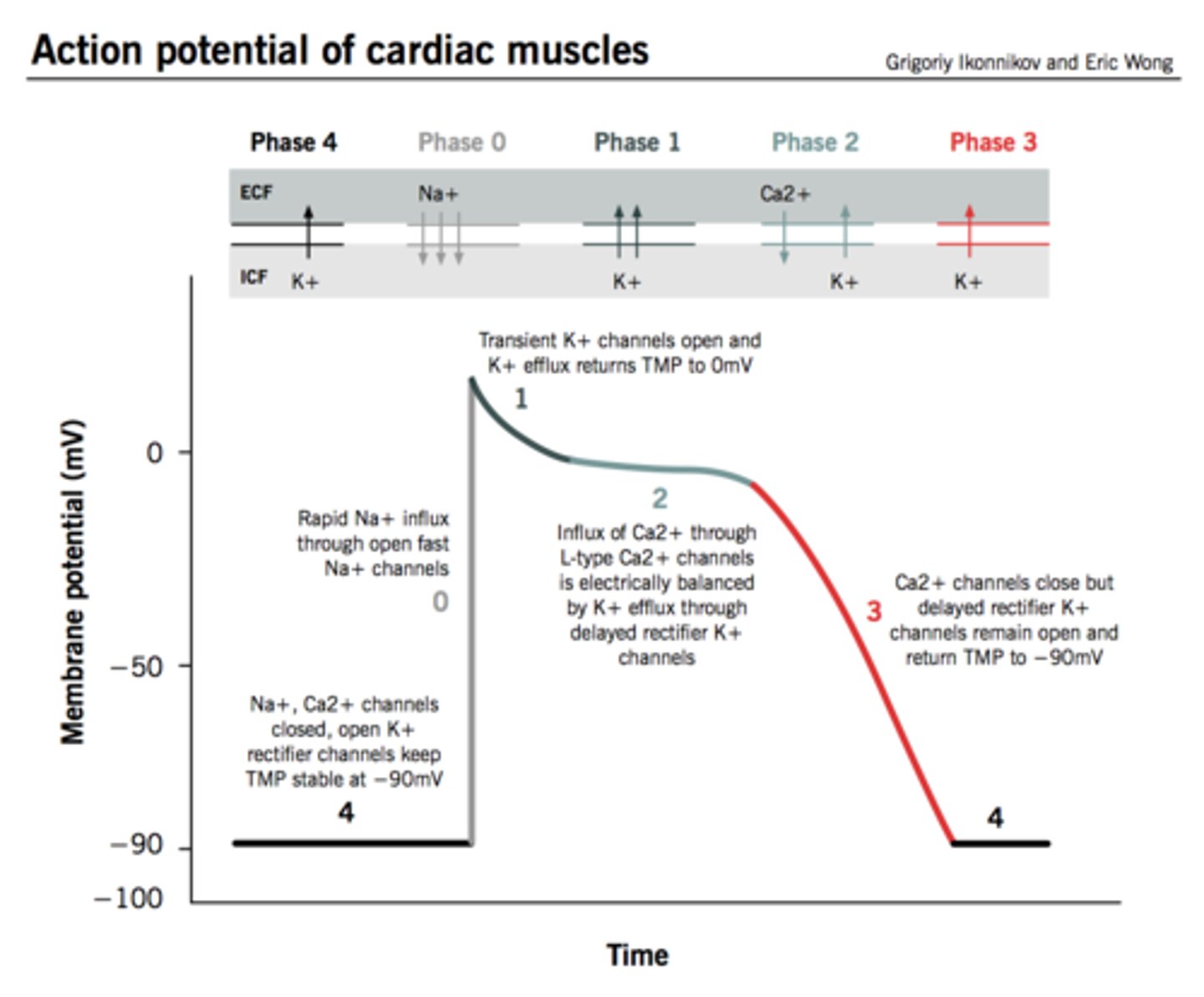
-90mV
The value of resting potential for cardiac muscle is
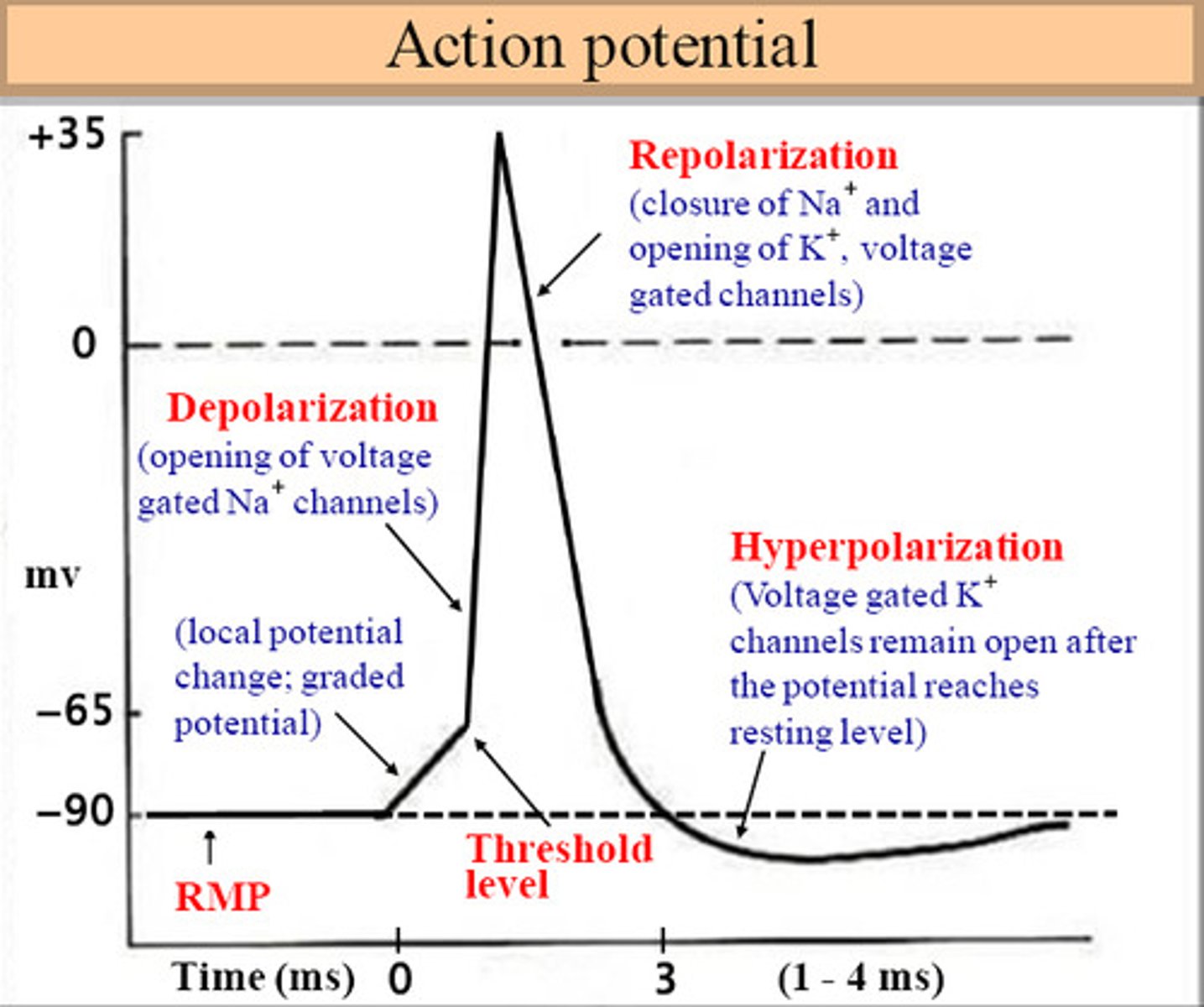
for contraction
Why is Ca2+ important for muscles?
Propagation of an action potential is a special way of impulse travel dependent on positive feedback. Since the membrane is refractory behind the leading edge of the Action Potential, it only moves in one direction. It follows the ALL OR NONE PRINCIPLE
How does propagation of an action potential work?
The all or none principle is the possibility that a graded potential becomes an action potential.
If the change in a membrane potential is <10 mV, then no change from graded potential to action potential will occur. BUT this change will occur when the change in potential membrane is >10mV, or greater than or equal to the action potential threshold
Explain the all or none principle
We have fibers type A, B, and C. The velocity of A>B>C.
Which type of fibers do we have? Compare their velocity.
More velocity = more diameter (directly related)
What does velocity relate to diameter of the fiber?
Myelin is an insulating layer, or sheath that forms around nerves, including those in the brain and spinal cord. It is made up of protein and fatty substances. This myelin sheath allows electrical impulses to transmit quickly and efficiently along the nerve cells. If myelin is damaged, these impulses slow down.
What is the function of myelin?
bare plasma membrane - voltage decays
non-myelinated axon - slow
myelinated axon - fast
Compare the speed of myelination/conduction speed for
1) bare plasma membrane
2) non-myelinated axon
3) myelinated axon
Continuous conduction
slow conduction that occurs in muscle fibers and unmyelinated axons
Saltatory conduction
Occurs in myelinated fibers, is more energy efficient and the travel time is faster
Neurofilaments
proteins that make up the axon
Free nerve ending
unspecialized nerve fibers that send signals to sensory neurons
Thermoreceptors
detect changes in temperature
node
isolated part of the axon that does not experience polarization
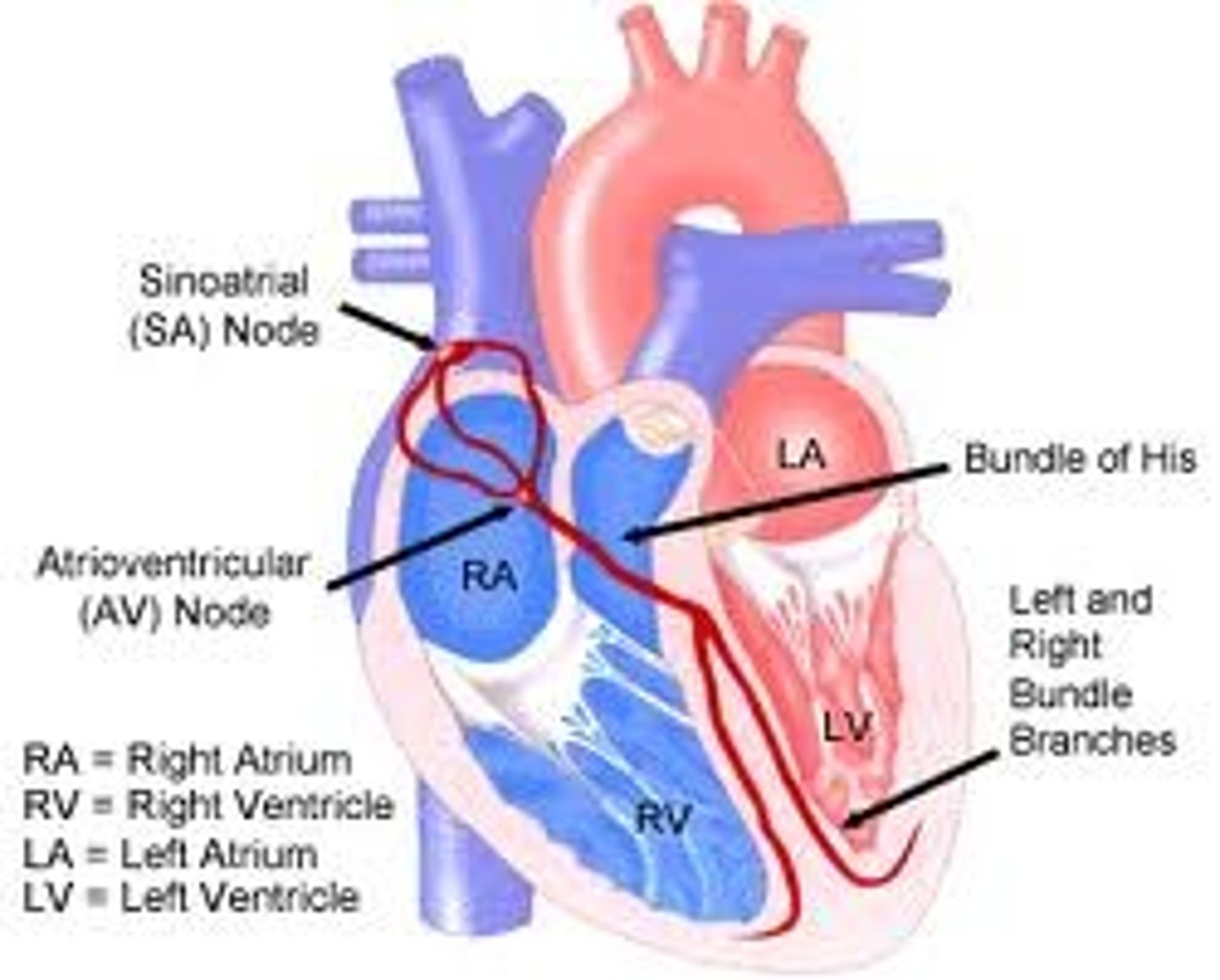
1 beat in the heart occurs every 0.8 seconds and there are 70-75 beats/min.
How fast does the heart beat? (How many beats/min and beats/sec?
Systole
Contraction of the heart; 120/80 mmHg
Diastole
Relaxation of the heart
Signal transmission
refers to the transference of the signal of synapses in human cells; occurs in two forms
Electrical synapses (gap junctions)
Chemical synapses
What are the two forms of signal transmission?
Electrical synapses occur thru gap junctions ("connexions")
They allow for
1) faster communication
2) synchronization
How do electrical synapses occur? What do they allow for?
Chemical synapses allow for one way transmission, which promotes a response in a post-synaptic target or muscle cell
Explain chemical synapses
Receptor and ligand
In the chemical synapse, communication occurs between the ______ and _______.
1) An action potential arrives at the axon terminal, depolarizing the membrane of the presynaptic terminal
2) Membrane depolarization from action potential causes an influx of calcium ions in the cell. (when the action potential reaches a terminal, there is an influx of sodium ions. This inward positive current causes a depolarization of the terminal, activating voltage-gated calcium channels that are embedded in the cell membrane of the axon terminals. Due to the electrochemical gradient of calcium, when the voltage-gated calcium channels are opened, calcium will rush into the cell.
3) Docking of synaptic vesicles packaged with small molecule neurotransmitters occurs through the interaction of three membrane-bound proteins called SNARE proteins.
4) Release of neurotransmitters into the synapse
5) Receptor activation
6) Postsynaptic potentials generated in postsynaptic cell summate
7) Neurotransmitter inactivation
Explain each step of chemical signaling
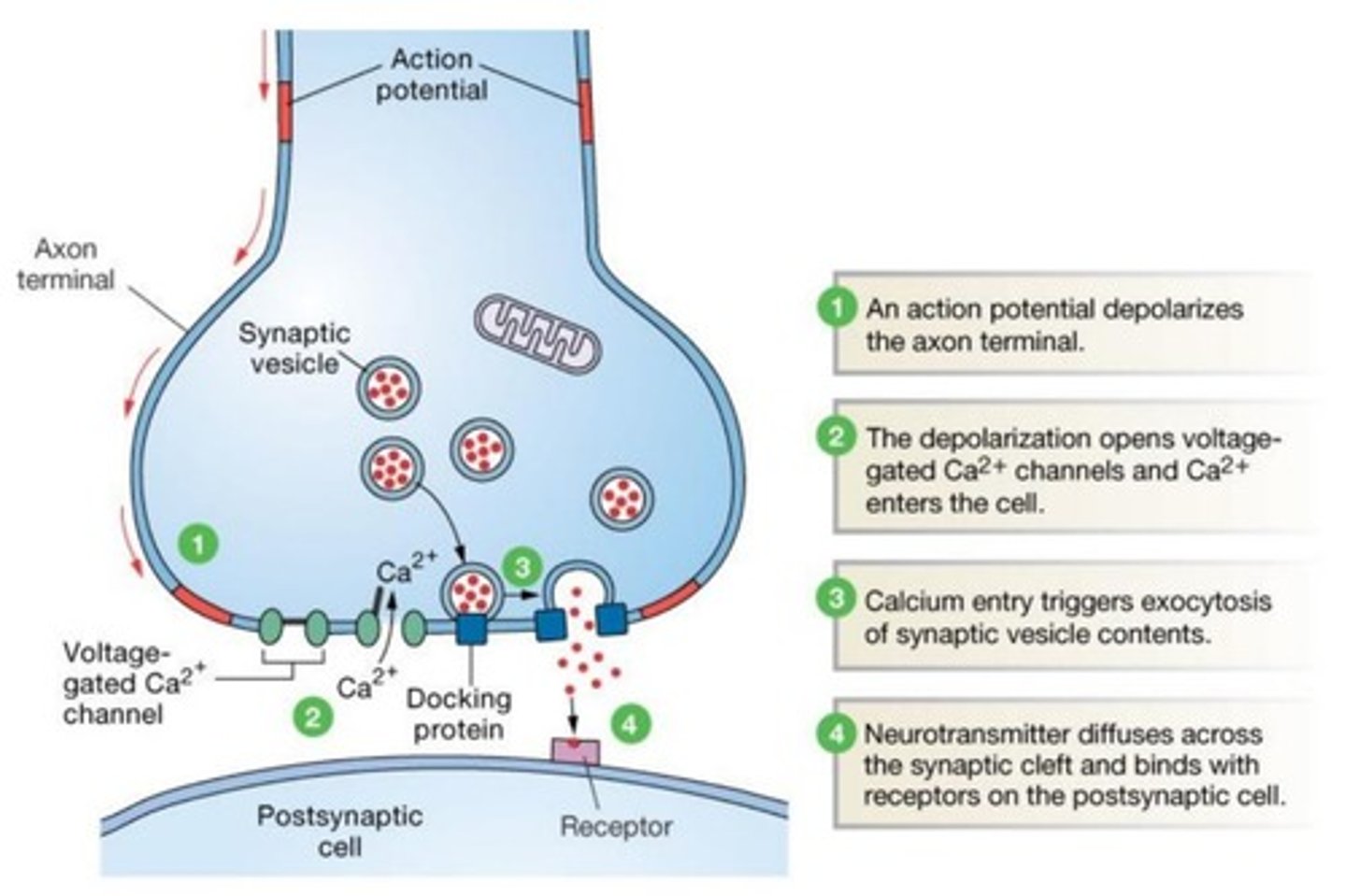
Spatial summation
Temporal summation
*remember they only occur in post-synaptic neurons
The two types of post-synaptic potentials in the Central Nervous System (CNS)
Spatial summation
refers to the cumulative effect on the membrane potential when multiple stimuli are applied simultaneously in different areas, using multiple synapses. graded potentials are generated with time and space in between, and they then generate an action potential

Temporal summation
a clinical measure of central sensitization in which "a high frequency of action potentials in the presynaptic neuron elicits postsynaptic potentials that overlap and summate with each other."
Neurotransmitters
Chemicals that transmit information from one neuron to another. This may cause an inhibitory or exhibitory change in the membrane potential
IPSP (inhibitory postsynaptic potential)
a slight hyperpolarization of a postsynaptic neuron moving the membrane potential of that cell further from the threshold
EPSP (excitatory postsynaptic potential)
depolarizing graded potential in postsynaptic neuron in response to activation of excitatory synapse
GABA, Glycine, and Serotonin - inhibitory
Acetylcholine (cholingeric neurons), Glutamate, and Norepinephrine (adrenergic neurons) - excitatory
Which neurotransmitters have inhibitory effects? Which have excitatory effects?
Acetylcholine (ACh)
a neurotransmitter involved in learning, memory and muscle movement; generated by the fusion of choline and an acetyl group
Glutamate
The most common neurotransmitter in the brain. Excitatory.
Gamma-aminobutyric acid (GABA)
a neurotransmitter whose low activity has been linked to generalized anxiety disorder
Glycine
Neurotransmitter in the CNS that is inhibitory; also an amino acid
Serotonin
A neurotransmitter that affects hunger,sleep, arousal, and mood; low amounts are linked to depression
ACh + muscarinic receptors = contraction
What makes up contraction?
diverging, converging, reverberating, parallel after discharge
The types of neuronal circuits are:
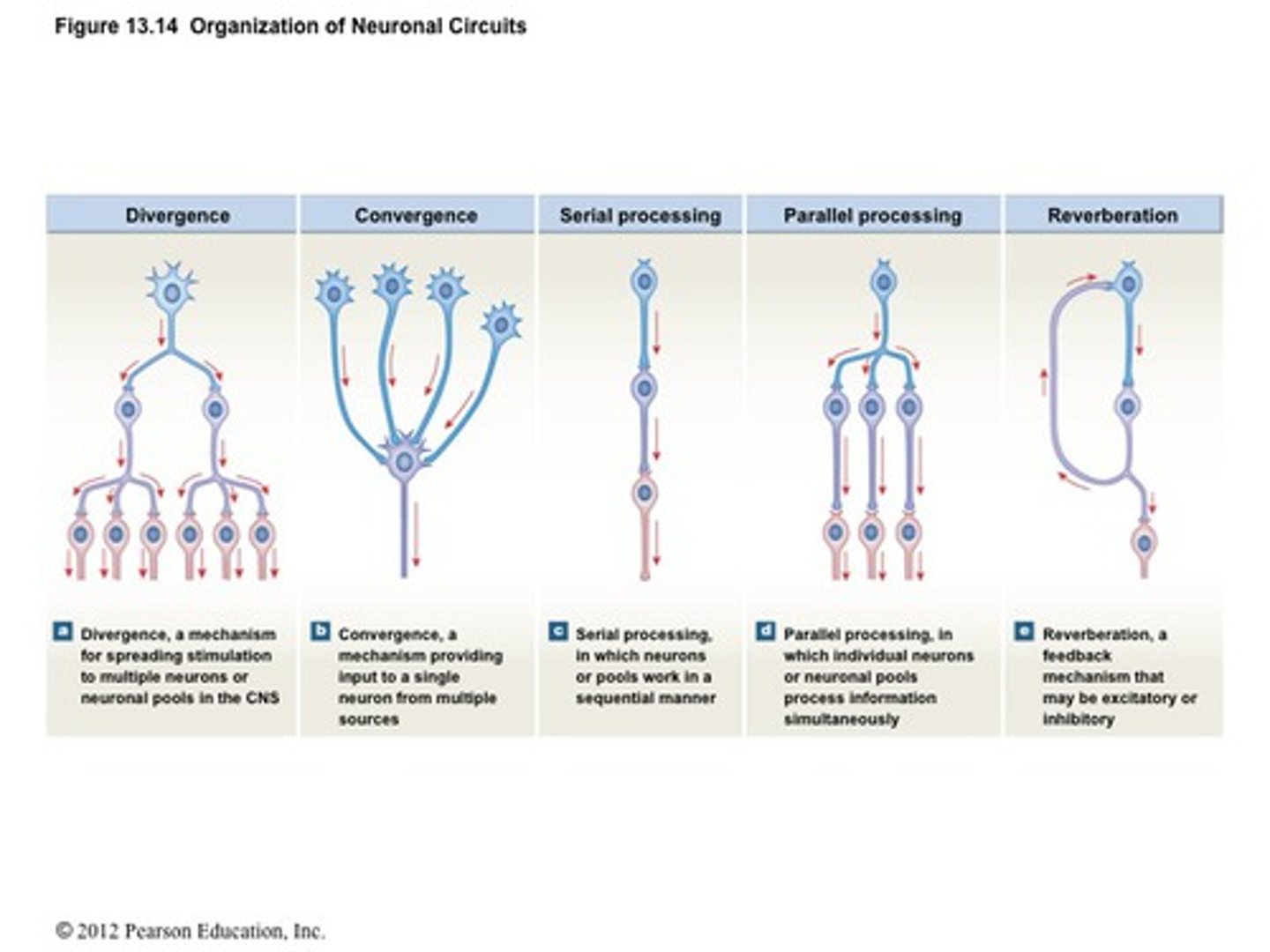
converging neuronal circuit
inputs from many sources are converged into one output, affecting just one neuron or a neuron pool.
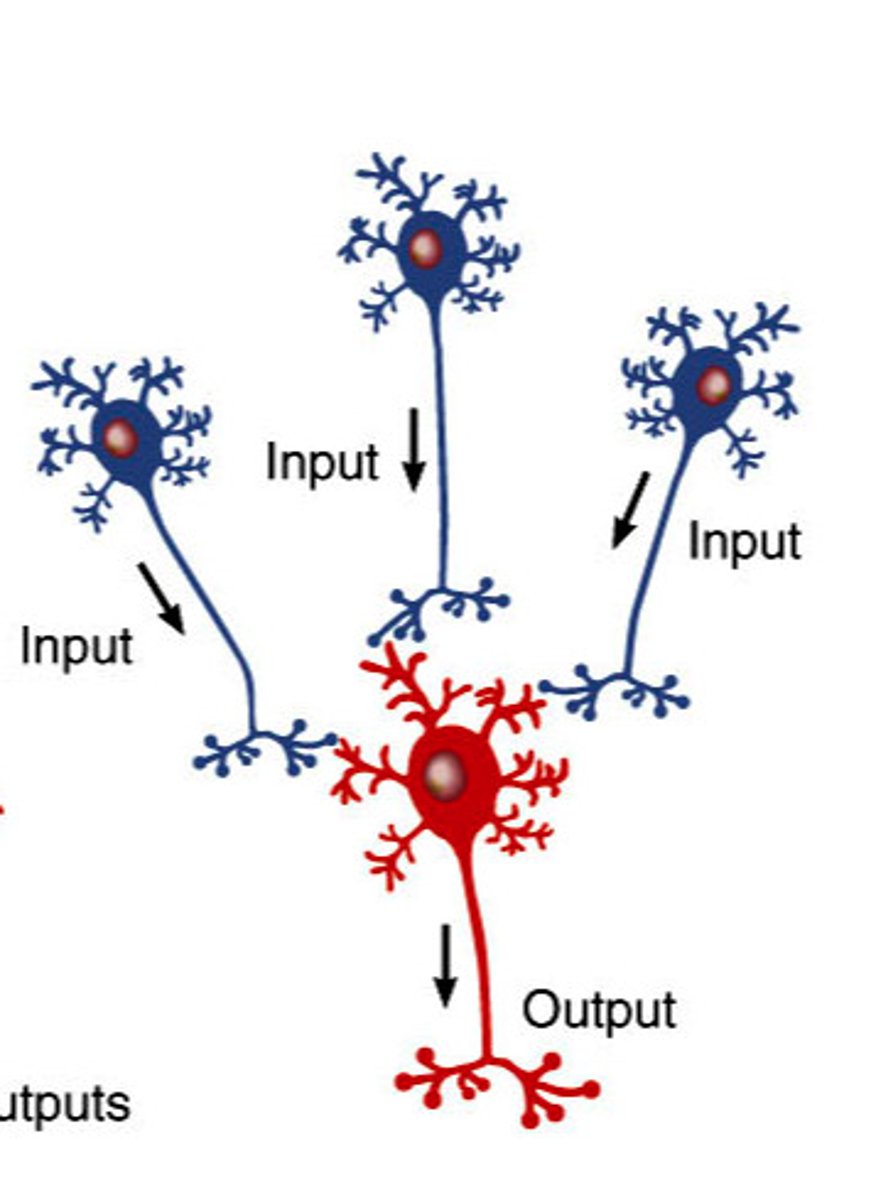
reverberating neural circuit
signal travels through a chain of neurons, each feeding back to previous neurons
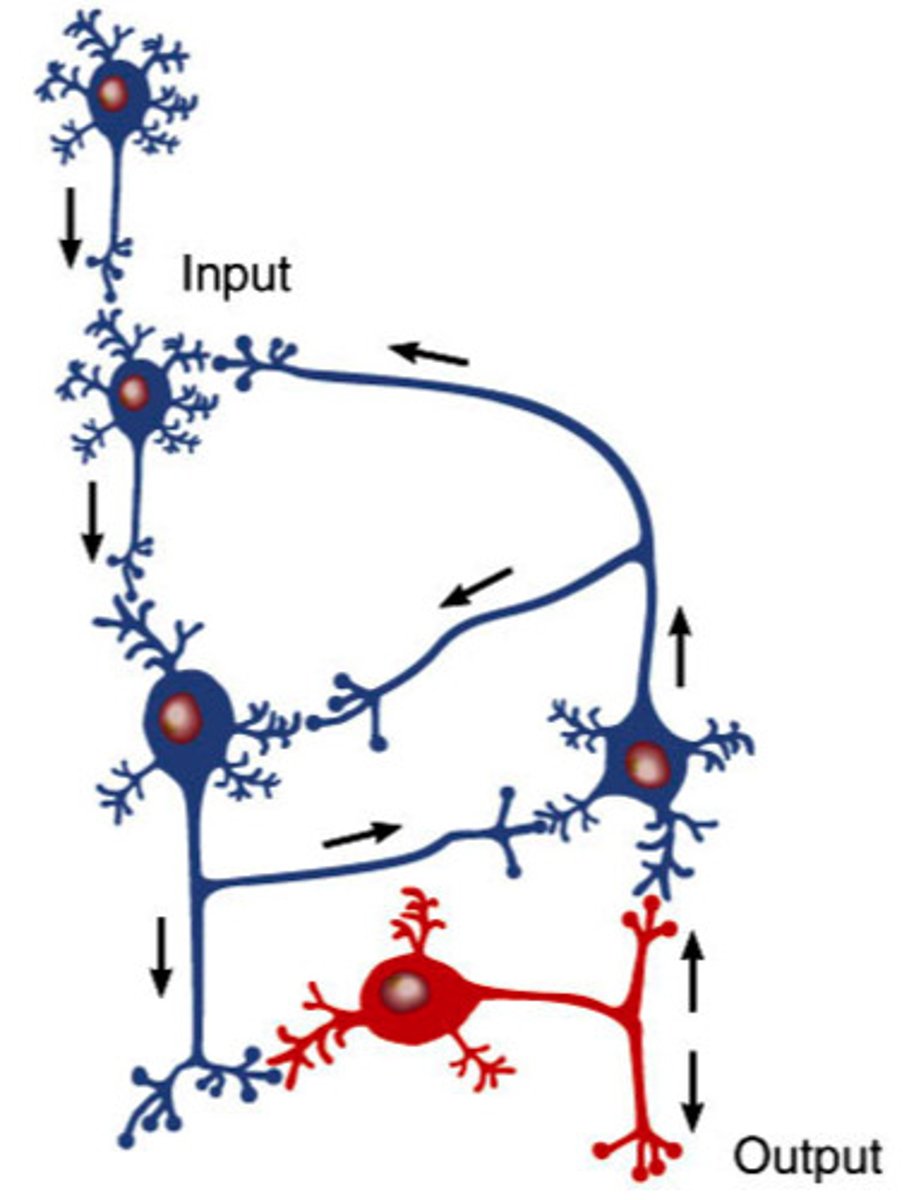
parallel after-discharge circuit
incoming fiber stimulates several neurons in parallel arrays to stimulate a singular common output cell
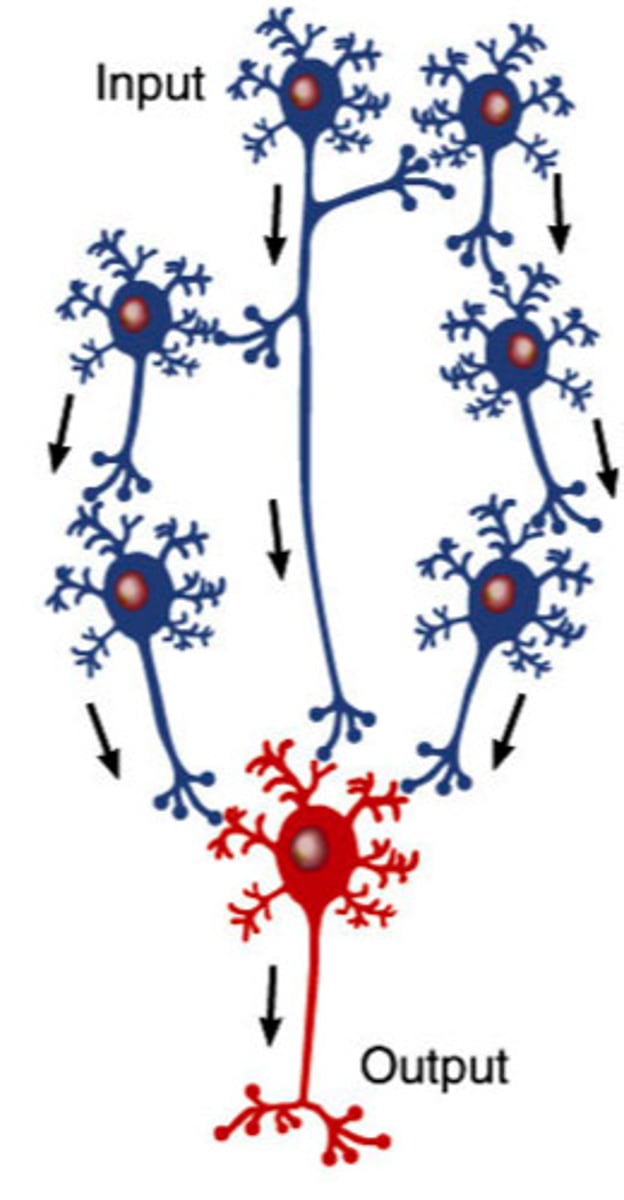
Graded potential:
1) Stimulus does not reach threshold level
2) Stimulus causes local change in membrane potential eg. -70 to -60 mV
3) It dies down over short distance.
4) Can be summated
5) Does not obey all or none law.
Action potential:
1) Stimulus reaches threshold level therefore causes AP.
2) Stimulus causes depolarization to threshold level.
3) It is propagated
4) Can not be summated
5) Obey all or none law
Compare graded potentials and action potentials:
In the soma and dendrites
Where do graded potentials occur?
Dendrites
Branchlike parts of a neuron that are specialized to receive information; they don't have voltage-gated channels
True
T/F: The cell membrane is composed of different chemical compositions
The inside surface has a relatively "negative" charge compared to the extraceullar space, producing a voltage difference or MEMBRANE POTENTIAL.
Explain the voltage difference of the gradient (inside space vs extracellular space).
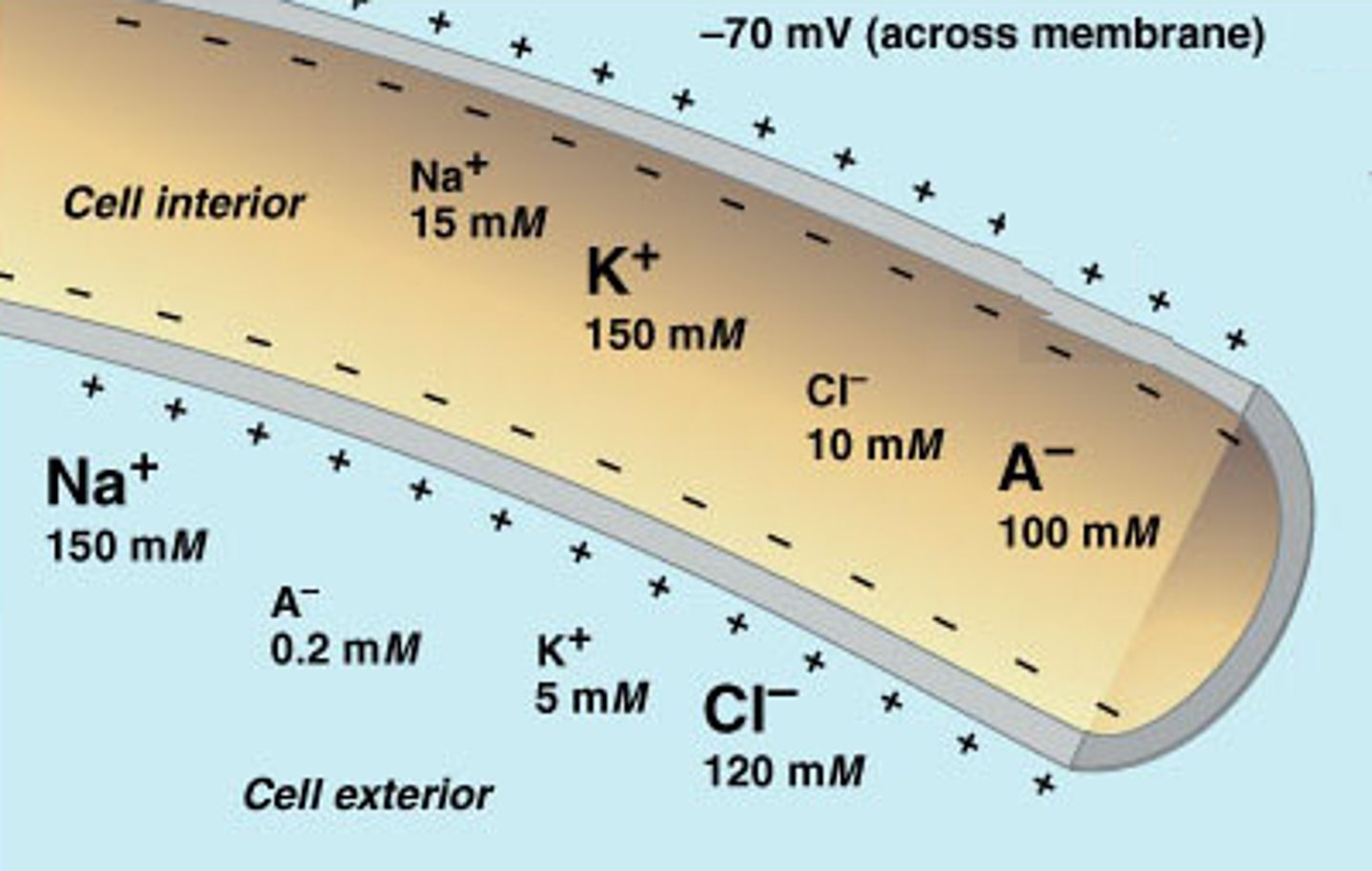
-70 mV (millivolts)
The resting membrane potential is:
-90 mV
What is the equilibrium potential of K+ ?
Electrical signals
These are used by excitable cells such as muscles and neurons
1) Leakage
2) Voltage-gated
3) Ligand-gated
4) Chemically-gated
5) Mechanically-gated
Electrical signals by neurons and muscle use 5 types of ion channels:
Leak-channels (example- cell membrane allows the leakage of K+ to maintain the electrochemical difference or production of an action potential
The gates are randomly opened or closed to maintain the electrochemical difference (diffusion potential)
1) Direct (Acetylcholine)
2) Indirect
2 types of chemically-gated channels:
Light ion channels
Type found in photoreceptors of the eye (cones and rods)
Hyperpolarization
Depolarization
Note- this only occurs in a localized region of the membrane since it travels for a short distance and dies out, so IT IS NOT AN ACTION POTENTIAL. It is a graded potential.
When a stimulus occurs in ligand-gated or mechanically gated channels, it produces a small deviation from the membrane potential producing-
-55mV
What is the threshold value for depolarization?
Restoration of resting membrane potential
What happens in repolarization?
1) resting state - all voltage gated Na+ and K+ channels are closed
2) depolarizing phase - depolarization to the threshold opens Na+ channel activation gates. Na+ inflow further depolarizes the membrane, opening more Na+ channel activation gates. membrane potential increases
3) repolarizing phase - Na+ channel inactivation gates close and K+ channels open. Outflow of K+ causes repolarization. membrane potential starts to decrease
4) repolarization continues - K+ outflow restores resting membrane potential. Na+ channel inactivation gates open. return to resting state (-70 mV) when K+ gates close.
Explain each phase in detail:
1) resting state
2) depolarizing phase
3) repolarizing phase
4) repolarization continues
Refractory period
Time during which an excitable cell cannot generate another action potential
Time in which a second potential cannot be initiated even with very strong stimuli. This coincides with period of Na+ channel activation and inactivation
What is the absolute refractory period?
During the absolute refractory period, voltage-gated Na+ channel activation gates and voltage-gated K+ channels are open, but Na+ channels are inactivating
During the relative refractory period, voltage-gated K+ channels are still open, but Na+ channels are in the resting state.
So what gates open/close during each period?
It is related to the diameter of the fiber and the presence or absence of myelin.
The speed of impulse is directly related to-
Axon hillock
cone shaped area between the axon and cell body; where the 1st stimulus is received before it moves to the synaptic bottle
Ach + nicotine = relaxation
What makes up relaxation?
diverging neuronal circuit
one neuron synapses with a number of postsynaptic cells
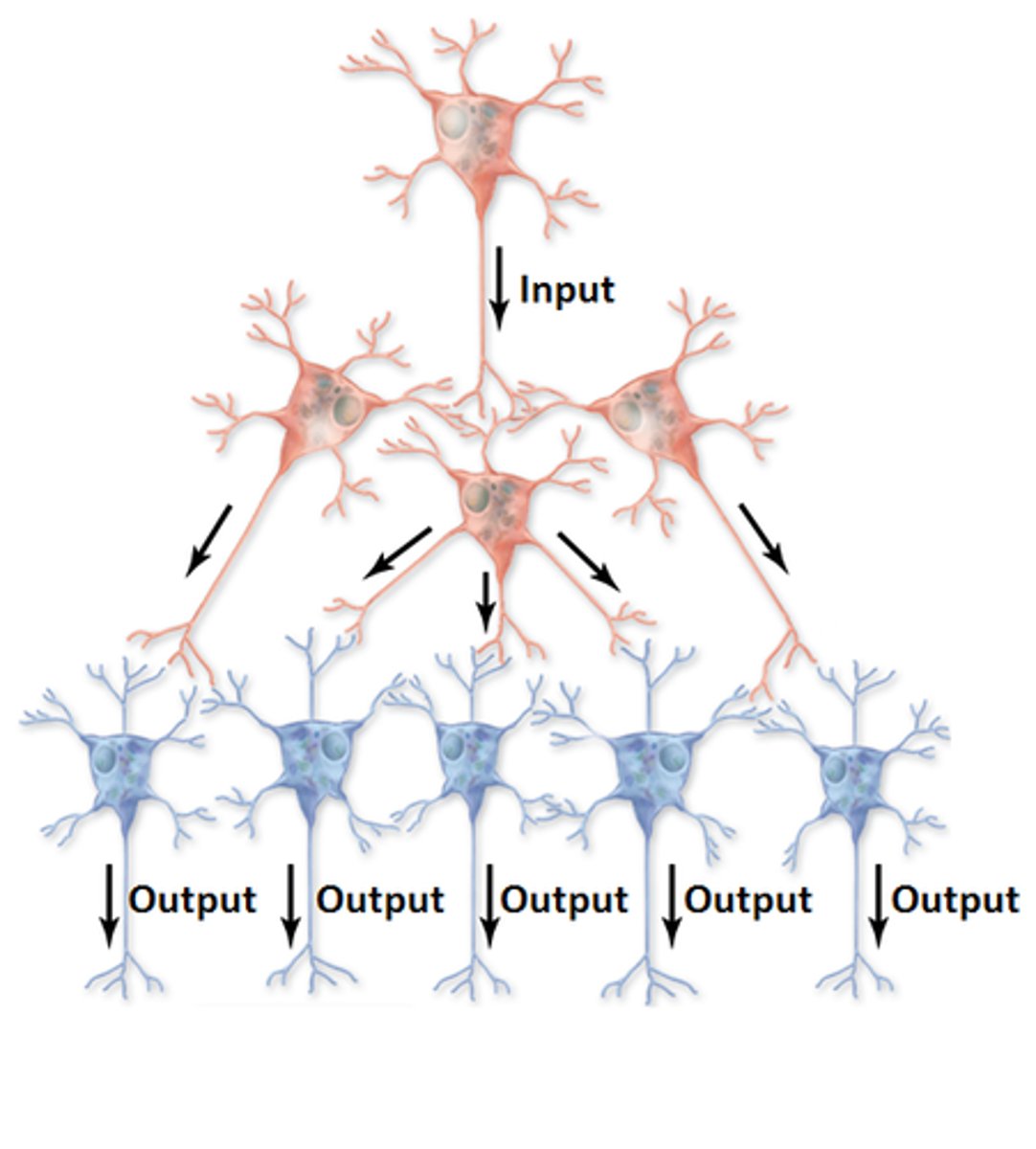
Soma
cell body of a neuron